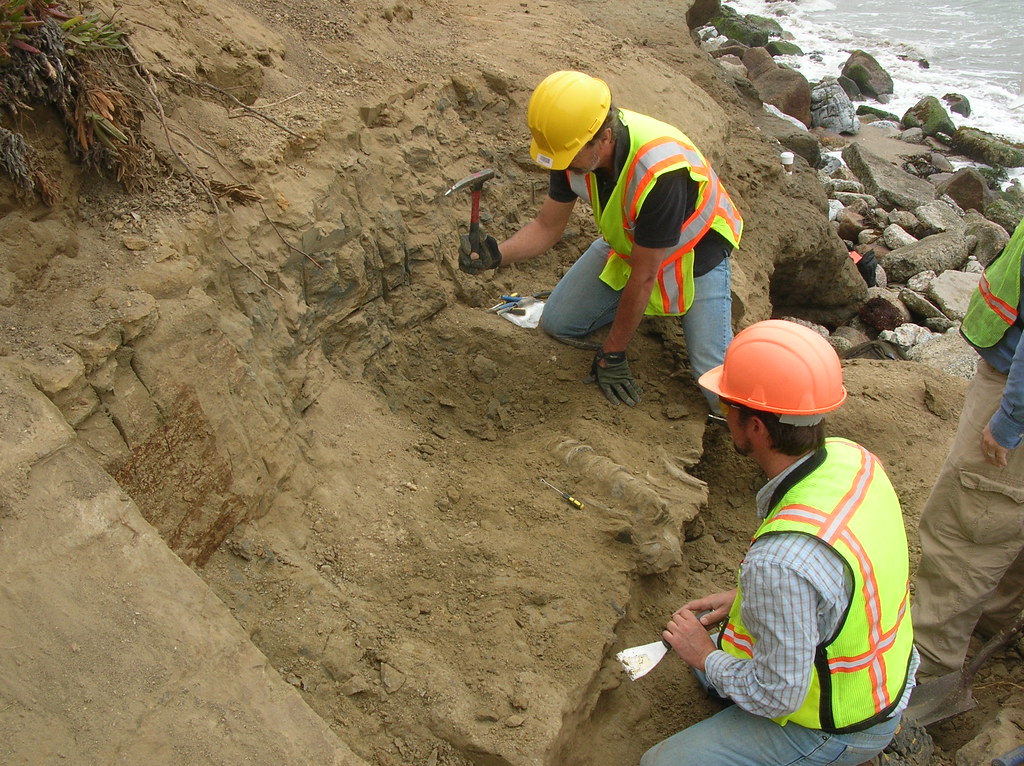 Not all fossils are discovered by paleontologists combing the earth on special expeditions. Many fossils are found by accident — particularly during construction projects. Impressive fossils, like whales, mammoths, and sloths, have been found while digging foundations for buildings, leveling land for highways, and excavating subway tunnels. This spring, the UCMP blog will take you on a tour of Bay Area construction sites, past and present, to show you some of the fossils underfoot in the region.
Not all fossils are discovered by paleontologists combing the earth on special expeditions. Many fossils are found by accident — particularly during construction projects. Impressive fossils, like whales, mammoths, and sloths, have been found while digging foundations for buildings, leveling land for highways, and excavating subway tunnels. This spring, the UCMP blog will take you on a tour of Bay Area construction sites, past and present, to show you some of the fossils underfoot in the region.
This week, Dave Haasl, a former Museum Scientist at the UCMP, tells us about his work with PaleoResource Consultants, a consulting firm that performs what is known as mitigation paleontology. If fossils are found on public lands during construction, the law requires that they be preserved. The fossils need to be excavated quickly, so that construction can carry on. And, the fossils need to be excavated by trained paleontologists, so they are properly preserved for future scientific study. This is a job for mitigation paleontologists! As Dave explains, “we need to mitigate the impact [of construction] to scientifically important resources. This includes fossils, as well as archaeological specimens.”
There are two parts to mitigation paleontology. First, the paleontologists do pre-construction field surveys. “We look at the stratigraphy of the area, and plot the potential fossil localities,” says Dave. Then, when those areas are dug up, workers know to be on the lookout for fossils. The second part of paleo mitigation is monitoring, which occurs throughout a construction project. Construction workers may not recognize fossils when they come across them, so it’s important to have a trained paleontologist on site. If fossils are found, the monitors halt construction and quickly excavate the fossils. They call in a network of paleontologists, and typically they are able to excavate the fossils within a few days.
Recently, two marine mammal skeletons, a whale and a dolphin, were found during the construction of a sea wall along the California coastline. Santa Cruz County is building a sea wall between Santa Cruz and Capitola, to protect the cliffs and buildings from large waves. However, the sea wall will block access to that section of the coastline, preventing any future paleontological exploration of the area. Paleontologists were asked to survey the area before the wall was built, to see if any fossils were present.
An amateur paleontologist had seen vertebrae protruding from the sandstone — these vertebrae belonged to a small whale that lived in the late Miocene, about 5 million years ago. PaleoResource Consultants excavated the specimen, wrapped it in plaster to protect it during transport, and brought it back to their offices in Auburn, California, where it is now being prepared.
A second skeleton, a dolphin, was found by Robert Boessenecker, a graduate student at Montana State University studying marine vertebrate fossils in California. The dolphin, now extinct, is also from the late Miocene, and is related to the Chinese river dolphin. “Marine mammals were much more diverse at that time,” says Dave.
While Dave’s career path as a paleo mitigation consultant may seem unusual, there is a real need for trained paleontologists in this field. “There is more paleo work in the West than paleontologists who can do it,” he says. “Often, archaeologists do the work, because paleontologists are not available.” And this work is important. As a result of big construction projects, fossil material is collected that otherwise would still be in the ground. These specimens are then used in scientific research. Says Dave, “This is our historic heritage. If it’s destroyed or sealed off, we’re losing something of potential scientific value. Yeah, we need roads, we need power plants. But we’re going to try to preserve as much of our past as we can.”
Learn more about fossils found during construction projects in upcoming blogs!
[flickr album=72157623549960334 num=5 size=Thumbnail]